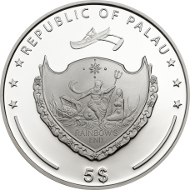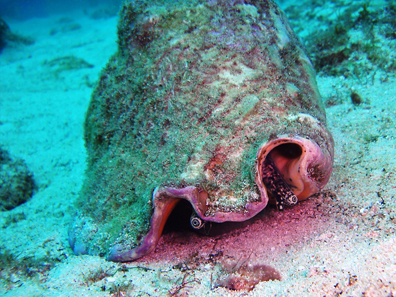March 20, 2014 – For the first time, a coin in the popular pearl series by Coin Invest Trust isn’t dedicated to a shell, but to a sea snail. The latest coin in the series shows a “queen conch”, native to the Caribbean. The issue with an inserted cultured pearl is a reminder that the queen conch is an endangered species.
Palau / 5 Dollars / 925 silver / 38.61 mm / 25g / Mintage: 2,500.
On the obverse the coin shows the matted coat of arms of Palau. Below, the nominal value, 5$. The centre of the reverse is occupied by a queen conch lying on a matted background resembling the seabed. A pink cultured pearl has been inserted into the depiction of the snail. The exergue bears the inscription “Beauty of the Sea”, which is the motto of this coinage, and the year of issue, 2014. The upper rim reads the name of the series, “Marine Life Protection”.
This coin is the first in the series to show a snail, not a shell. All previous editions of the pearl series are being sold out proves the popularity of the maritime theme. The coins are minted by B.H. Mayer’s Kunstprägeanstalt GmbH.
A queen conch. Photograph: divemasterking2000 / http://creativecommons.org/licenses/by/2.0/deed.de
The question how pearls are created can still not be answered with complete certainty and remains a fascinating wonder of nature. Biologists assume that intruding parasites trigger a reaction, a defence mechanism which covers the irritant with layers of calcium carbonate. Usually, only shell beads fulfil the high aesthetic expectations that are demanded in the jewellery market. However, there are also other animals that are able to create pearls. One of the few gastropods able to create durable and at the same time beautiful pearls is the queen conch (Lobatus gigas).
This sea snail is native to the Caribbean and can reach up to 30 cm. Instead of gliding on a slime trail, this species uses a foot to thrust its body forwards and move by leaping over the ground. With this unusual means of locomotion, the snail reaches a considerable speed and can even master vertical ascents onto rocks. Before they reach sexual maturity at the age of 3 to 4 years and move to deeper waters, the animals tend to stay in shallow waters. When they reach sexual maturity, the snails have a size of only 18 cm, but already weigh 2.5 kg. In their new habitat, this animal can grow as old as 20 to 30 years, sometimes even older. However, the new habitat also poses new dangers. Apart from the queen conch’s many natural enemies – other snails, starfishes, fishes and sea turtles, humans remain its most dangerous enemy. In the Caribbean, the meat of the queen conch is considered a delicacy and its shell used for craftwork. By now, the population has been dangerously reduced due to overfishing and the animal is listed as an endangered species according to the Washington Convention.
The queen conch’s pearls are usually pink. The optical reflectance effect they produce is referred to as chatoyancy by experts. This “cat’s eye effect” can also be observed in gem stones. Techniques for cutting shell pearls have only beed discovered a few years ago. Without harming them, a foreign body is inserted into the animal, which is then covered in more and more layers of calcium carbonate until the desired pearl is formed.
For more information on Coin Invest Trust and their products go to the company’s website.
In this video you can learn something about cultured pearls from the queen conch.
And here you can see a queen conch “in action”.







